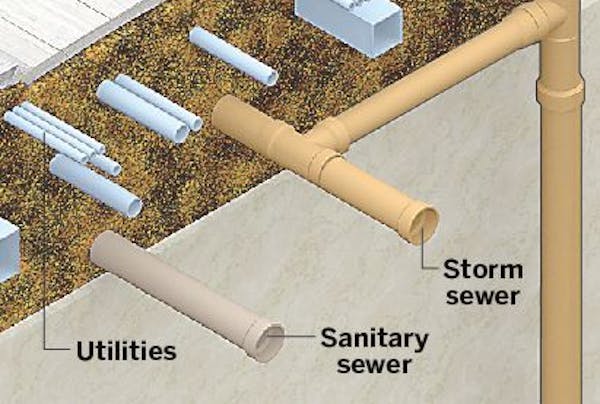Tunnels deep below downtown Minneapolis that deliver torrents of rain from the streets to the Mississippi River are bursting at the seams, and the cost of adding a new one to ease the pressure could show up in residents' monthly water bills.
The $38 million project to dig a new passage 70 to 100 feet beneath Washington Avenue, beside an existing one, would be the largest of its kind downtown since the system was built about 80 years ago. The city has been fixing up its tunnels for about a decade to head off mishaps like a 2010 sewage spill into the river, caused by surging rainwater beneath 2nd Avenue that burst through a liner into a nearby sewer.
The urban center of the Twin Cities is crisscrossed by subterranean passages that make day-to-day life possible above ground. Carved through the softer material below a layer of limestone, in places as deep as 11 stories, these tunnels use gravity to deliver water to the river or to a sewage treatment plant.
The city has been giving underground tours to City Council members and legislators to make the case for fixing an unseen problem. Minneapolis is seeking $19 million from the Legislature to defray the cost of its Washington Avenue project, which could begin construction in 2020.
"The tunnels were built to handle much less water, so even when it's raining moderately it means they're full," said Katrina Kessler, the city's director of surface water and sewers, on a tour of a tunnel in southeast Minneapolis.
On a recent afternoon, Kessler sloshed through rushing water and used a headlamp to point out cracks in the tunnel wall. "Right here you can see that there was a big hole and we filled it with grout," she said.
Council Member Steve Fletcher, who took the tour, said he wishes more city residents who wonder where their tax dollars go could pay a visit to the tunnels.
"There's a tremendous amount of work and technical expertise and effort that goes into things that we never see, happening 80 feet below us," Fletcher said.
Without the state aid, public works officials say city residents could see a 20 percent spike over four years in their stormwater fees — which are normally stable. That could mean an extra $2.40 per month for a typical single family home, or about $70 more each month for the owner of an apartment building.
"We are hopeful the Legislature can recognize the value that this project brings not only to the city but the region and the state," Kessler said.
The project wasn't included in Gov. Mark Dayton's bonding bill, and neither the House nor the Senate has released its bonding proposal. It is third on the city's list of bonding priorities, behind an overhaul of the Upper Harbor Terminal property and an expansion of the city's emergency operations and training facility.
Kessler said the city intends to move forward regardless of whether the Legislature funds the project.
The tunnels are significantly deeper than the other essential conduits beneath the sidewalks. Most gas, electric and communications lines on Nicollet Mall are 3 to 5 feet below ground, just above water mains and sewer pipes.
Once stormwater drops to the tunnels, it flows by gravity toward Washington Avenue, where it follows the street's path underground for several blocks before being spit out into the river beside the Stone Arch Bridge. The tentative plan is to build another tunnel beside the existing one to reduce pressure across the downtown system.
"We find credit cards, driver's licenses, money, all the time when we're down there because of the restaurants and everything around," said Kevin Danen, the city's sewer operations engineer.
It's not the only deep tunnel work happening in the city. The Minnesota Department of Transportation has spent nearly four years burrowing 120 feet below Interstate 35W in south Minneapolis and repairing its stormwater tunnels there. And the Metropolitan Council is preparing to repair a wastewater tunnel near Minnehaha Park that's as deep as 74 feet underground.
Including tunnels outside downtown, the city's system spans nearly 16 miles, ushering rainwater from about a fifth of the city to the river. St. Paul has 20 miles of tunnels that perform a similar task.
Workers carved many of them into the sandstone using pick axes and high-pressure water hoses, then sealed them with concrete. It was dangerous work, and remains so. Two contractors working on a St. Paul stormwater tunnel died in 2007 when it was flooded by a sudden downpour.
There were also unusual discoveries. In a 1931 Minneapolis Star article, city engineer Carl Illstrup recalled crawling through "narrow fissures and crevices" — packed with toxic gas — deep below today's Old Republic Title building on 2nd Avenue.
He emerged in a domed cavern featuring a lake and a 30-foot-wide curtain of water spilling into it. "It was a beautiful sight," he told a reporter. "But we had to drain it."
When the downtown tunnels were built, the city's core still had some unpaved surfaces left to absorb stormwater. Now nearly everything that falls on downtown flows into the tunnels.
"We certainly have more concrete in downtown than we used to," Kessler said, combined with "more intense, frequent rain events."
Since 2009, Minneapolis has spent $2 million to $5 million a year largely on repairing breaks in the lining. Pressurized water over time fractures the concrete, creating voids in the surrounding sandstone that further compromise the tunnels' strength.
St. Paul has spent about $3.5 million to $4 million per year since 2006 on rehab work, said Bruce Elder, the city's sewer utility manager. It is now working on a Phalen Creek tunnel northeast of downtown.
"We're more or less working within the existing tunnel and making repairs," Elder said. "We don't really have a great need for additional capacity."



